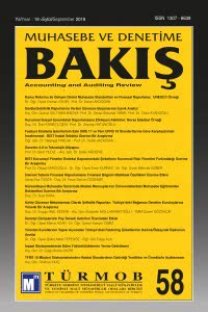KURUMSAL SOSYAL VE ÇEVRESEL RAPORLAMA PERFORMANSININ ÖLÇÜLMESİ İÇİN BİR MODELLEME YAKLAŞIMI
Bu çalışmanın amacı kurumsal sosyal ve çevresel raporlama performansının ölçülmesi için bir modelleme yaklaşımı geliştirmektedir. Bu amaç kapsamında beş aşamalı, ağaç yapılı bir performans modeli sunulmaktadır.Sunulmakta olan modelleme yaklaşımı ile sosyal ve çevresel raporlama performansının etkin ve karşılaştırılabilirolarak ölçülmesinin mümkün olabileceği öngörülmektedir
Anahtar Kelimeler:
Sosyal ve çevresel raporlama, modelleme yaklaşımı
A MODELING APPROACH FOR MEASURING CORPORATE SOCIAL AND ENVIRONMENTAL REPORTING PERFORMANCE
The aim of this study is to develop a modeling approach to measuring the performance of corporate social andenvironmental reporting. Under this purpose, five-stage tree structured performance model is presented. Socialand environmental reporting performance modeling approach that is being presented is expected to be able tomeasure the reporting performance effective and comparable
Keywords:
Social and environmental reporting, modeling approach,
___
- Adams, C. (1999). The Nature and Processes of Corporate Reporting on Ethical Issues 4, Londra: The Chartered Institute of Management Accountants (CIMA).
- Aydın, S. (2015). “Kurumsal Raporlamanın Evrilme Sürecine İlişkin Bir İrdeleme”, Mali Çözüm, 130, 61-72.
- Berkhout, T. (2005). “Corporate Gains: Corporate Social Responsibility can be the Strategic Engine for LongTerm Corporate Profits and Responsible Social Development”, Alternatives Journal, 31(1), 15-18.
- BIST, (2014). Şirketler İçin Sürdürülebilirlik Rehberi http://www.borsaistanbul.com/data/kilavuzlar/surdurulebilirlik-rehberi.pdf, Erişim: 30 Mayıs 2016
- Bowen, H. (1953). Social Responsibilities of the Businessman, New York: Harper.
- Carroll, A.B. (1991). “The Pyramid of Corporate Social Responsibility: Toward the Moral Management of Organizational Stakeholders”, Business Horizons , 34, 39-48.
- Carroll, A.B. (1979). “A Three-Dimensional Conceptual Model of Corporate Performance”, The Academy of Management Review, 4 (4), 497-505.
- Clikeman, P.M. (2004). “Socially Conscious Corporation”, Strategic Finance, Nisan, 23-27.
- Deegan, C. (1999). “Implementing Triple Bottom Line Performance and Reporting Mechanisms”, CA Charter. 70 (4), 40-42.
- DEFRA, (2006). “Environmental Key Performance Indicators”, Londra: UK Department for Environment, Food and Rural Affairs.
- DVFA, (2010). “Key Performance Indicators for Environmental, Social & Governance Issue”, Frankfurt: Society of Investment Professionals in Germany.
- Dyllick, T. ve Hockerts, K. (2002). “Beyond the Case for Corporate Sustainability”, Business Strategy and the Environment, 11, 130-141.
- Eccles, R.G. ve Michael P.K. (2010). One Report: Integrated Reporting for a Sustainable Strategy, New York: John Wiley & Sons, Inc..
- Freeman, R.E. (1984). Strategic Management: A Stakeholder Approach, Boston: Cambridge University Press.
- Friedman, M. (1970). “Social Responsibility of Business”, New York Times Magazine, 13, September, 122-126.
- Gray, R. ve Bebbington, J. (2007). Accounting for the Environment, Londra: Sega Publications.
- GRI, (2015). “G4 Sürdürülebilirlik Raporlaması Kılavuzları”, Amsterdam: Global Reporting Initiative.
- Hackston, D. ve Milne, J.M. (1996). “Some Determinants of Social and Environmental Disclosures in New Zealand Companies”, Accounting, Auditing and Accountability Journal, 9(1), 77-108.
- IIRC (International Integrated Reporting Council), (2013). Uluslararası Entegre Raporlama Çerçevesi. http://integratedreporting.org/wp-content/uploads/2015/03/13-12-08-THE-INTERNATIONAL-IR-FRAMEWORK-Turkish.pdf, Erişim: 25 Mayıs 2016
- Kestigian, M. (1991). “The Greening of Accountancy”, Australian Accountant, 61 (8), 20-28.
- Kocmanova, A. Nemecek, P. ve Docekalova, M. (2012), “Environmental, Social and Governance (ESG) Key Performance Indicators for Sostainable Reporting”, 7th Scvientific Conference Business and Management, 10-11 Mayıs, Vilnius, Litvanya.
- KPMG, (2015). “Survey of Integrated Reports in Japan”, Integrated Reporting Advisory Group in Japan.
- Novo Nordisk, (2015). “Annual Report”, http://www.novonordisk.com/content/dam/Denmark/HQ/Commons/documents/Novo-Nordisk-Annual-Report-2015.PDF Erişim: 1 Haziran 2016
- Strange, T. ve Bayley, A. (2008). Sustainable Development: Linking Economy, Society, Environment, OECD Insights, OECD Publishing.
- UN (United Nations), (1987). Our Common Future, Report of the World Commission on Environment and Development, General Assembly Resolution 42/187, Aralık, http://www.un-documents.net/our-common-future.pdf, Erişim: 31 Mayıs 2016
- UNCTAD, (2008). “Guidance on Corporate Responsibility Indicators Inannual Reports”, New York ve Cenevre: United Nations.
- Wilson, M. (2003). “Corporate Sustainability: What is It and Where does It Come from?”, Ivey Business Journal, Mart-Nisan, 1-5.
- Yanık, S. ve Türker, İ. (2012). “Sürdürülebilirlik ve Sosyal Sorumluluk Raporlamasındaki Gelişmeler (Tümleşik Raporlama)”, İ.Ü. Siyasal Bilgiler Fakültesi Dergisi, 47, Ekim, 291-308.
- ISSN: 1307-6639
- Yayın Aralığı: Yılda 3 Sayı
- Başlangıç: 2000
- Yayıncı: TÜRMOB
